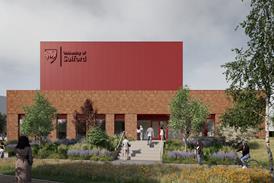The leader of the body, which launched its manifesto this week, was speaking at a fringe event on the RAAC crisis
Muyiwa Oki has called for educational buildings to be designed with longevity in mind in the wake of the RAAC crisis which has plagued the start of the academic year.
Speaking at a fringe event on the topic at the Conservative Party conference yesterday, the RIBA president suggested maintenance regimes could be agreed at the procurement stage where products have a limited lifespan.

“RAAC has a shelf life, which is thirty years, and if you build a building for a particular time period and the materials within that […] have a different shelf life you then have an issue,” he said.
“We need to design buildings from a 100 years and we need to think about how we do that from the inside out.
“So the core materials need to be designed for 100 years and the outer skins need to be designed so that it can be reused, repurposed”
“We need to ensure that when we are thinking about the buildings we are using, that they are designed for the life that they need and if it goes beyond that, we put in that maintenance regime at procurement”.
The new president – RIBA’s first black leader and its youngest – also addressed the scale of the ecological challenge posed by the educational buildings, noting that 37% of public sector emissions came from the schools estate.
“Education buildings are the public sector’s biggest carbon emitters […] and it shows that there is some way to go in thinking about and redesigning good design for our public schools and their estates,” he said.
“Good design looks like good acoustics, good thermal comfort, cross ventilation – the fact that we are doing that for new schools is great, but we need to think about the existing infrastructure that we have and think about how they can meet these new targets and challenges. So there is more that needs to be done”.
> Also read: ‘I don’t seek permission, I ask for forgiveness’ – Muyiwa Oki on his plans for his RIBA presidency
On the same panel, Baroness Barran, a minister for the Department for Education (DfE) who recently fielded RAAC-related questions at a commons select committee, refused to give any updated figures on the number of schools affected by RAAC or the proportion of responsible bodies that have now returned their surveys.
At last estimate, 174 schools had identified RAAC, while 98.5% had returned their questionnaires to the DfE.
Paul Whiteman, general secretary of the National Association of Head Teachers, said the department’s response to the crisis had “not been too bad at all” but noted that the issue had been known about for a long time.
> Also read: Collapse that sparked school closures caused by bearing failure, says DfE official
> Also read: Does the latest RAAC research mean remediation could be easier and cheaper than all the panic suggests?
“It talks to our wider ambition – we were prepared to take decisions that allow buildings to decay,” he said.
“When the government tells you that we need to build 400 schools a year but we will fund just 50, that tells me a lot about our lack of ambition for young people”
The RIBA president’s comments on school buildings come as the organisation launched its ‘Manifesto for a Better Built Environment’, which called on policy makers to place more focus on quality, safety and sustainability in the design and construction of buildings.
The institute called for greater investment in the capacity of local planning departments and reiterated its long-standing call for a national retrofit strategy.
It also demanded the introduction of targets that take into account the whole life carbon of buildings, including both embodied and operational carbon.
In a statement, Oki said: “Well designed buildings and places enrich our lives, positively impact the environment, and strengthen our communities.
“Our manifesto highlights the need for conscious and concerted policy action to deliver a built environment that meets peoples’ needs, both now and in the future.”
















2 Readers' comments